It’s Holy Saturday today, the day in between Good Friday and Easter Sunday. It’s the final day of Lent and a time about which scripture is virtually silent. That silence is perhaps an invitation into a time of silent reflection.
I’ve been reflecting a little on my Maundy Thursday service earlier this week. If you missed it you can find it here: https://www.youtube.com/watch?v=tIxoPGhY9w0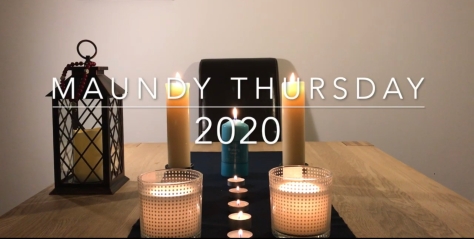 The table from which I led the service was decorated with candles, some of which are extinguished during the service, but without explanation.
The table from which I led the service was decorated with candles, some of which are extinguished during the service, but without explanation.
Those candles are perhaps more significant than they might at first appear. What do you notice when you look at them? First, you might notice that different kinds of candles make up the display: tea light candles in the middle, short and fat candles in spotted glass jars in the foreground, tall and elegant candles towards the back, a blue candle in the middle and a lantern candle off to the left. What’s not visible is that some of the candles are scented and the others are not.
First, you might notice that different kinds of candles make up the display: tea light candles in the middle, short and fat candles in spotted glass jars in the foreground, tall and elegant candles towards the back, a blue candle in the middle and a lantern candle off to the left. What’s not visible is that some of the candles are scented and the others are not.
Second, you might notice that the display is not symmetrical. If you draw an imaginary line from the centre of the lantern candle through the glass jar and to the tea light at the very front of the image and then draw a corresponding line through the other glass candle you’ll arrive at nothingness. This is because a candle is missing from the top right of the display.
Third, you might notice the number of candles in the display. To save you counting, its 11. Candle number 12 is missing. What you can’t see, unless you have x-ray vision, is that candle number 12 isn’t actually missing. It’s in the room next door, through the wall behind the chair.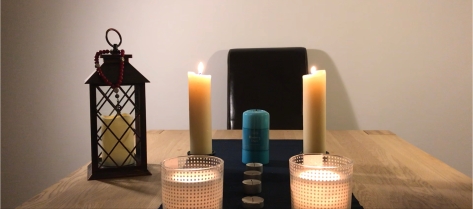 Fourth, part way through the service the central candles are gradually extinguished. I initially planned over the course of the service to extinguish all but one of the candles, but I feared it might make it too dark to film, so I settled for extinguishing the middle candles only.
Fourth, part way through the service the central candles are gradually extinguished. I initially planned over the course of the service to extinguish all but one of the candles, but I feared it might make it too dark to film, so I settled for extinguishing the middle candles only.
You might, by now, have begun to see where I’m going with this. The candles for me tell something of the story of Christ’s passion.
The candles represent for me The Twelve disciples who gathered at the table with Jesus for his Last Supper Maundy Thursday. The candles are not only different but also come from different places. The tea lights are pretty generic. I’ve no idea where they come from. The glass jar candles are from Sainsbury’s and are scented as is the central blue candle, from ASDA George. The tall elegant candles have been knocking around for years. The lantern candle is from T K Maxx I think.
Similarly, the Twelve were very different people. There were two sets of brothers among the disciples, Peter and Andrew and James and John. They might have shared some filial similarities but the others are all quite different. This display would have been very different if all the candles had been the same. It’s their very difference which makes it an attractive thing.
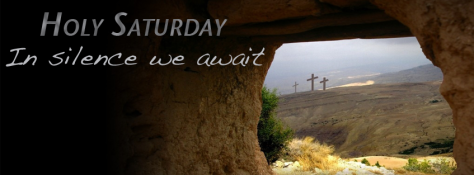
God, forgive us when we want other people to be more like us. Give us the grace to celebrate the differences in those you call us to accompany in life.
At the end of the meal Judas left the room, in order to betray Jesus. hence, an asymmetrical display of 11 rather than 12 candles. Immediately after a meal, in which Jesus washed his feet, Judas went off to collect his 30 pieces of silver, and then betrayed Jesus with a kiss.
Betrayal is a deeply wounding thing. If someone of whom we had lower expectations of had done this thing, we might have felt less wounded. But that it is someone close to us, one we love, that is what hurts so deeply.
Sometimes we feel betrayed by the actions of people we love. Sometimes it’s more than simply a feeling of betrayal. Sometimes we are actually betrayed and that’s a hard thing to overcome.

God, heal us from the wounds of betrayal from ones we love most. We pray for those who like Judas have gone missing from our lives, and have left a hollow space that can’t be filled.
The extinguished candles represent for me the disciples who may not have betrayed Jesus but they certainly failed to stand with him. Initially, in the Garden when they could not stay away to pray with him, and ultimately at the cross when they all abandoned Jesus. This is, of course, only true of The Twelve. The women, never abandoned Jesus. They stayed to the bitter end and were the first on the scene on Sunday. But the men all left.
Apart from one. That’s one of the reasons I initially intended to extinguish all the candles apart from one. John’s Gospel records that one disciple stayed, the Beloved Disciple. That disciples is never named, but traditionally it is thought to be John himself.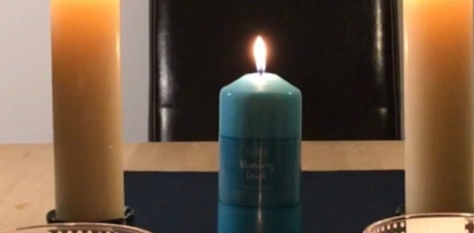 I’ve not really thought to assign any of the candles to a particular disciple. But I confess that I think of the blue central candle as especially resonant of Peter. It’s the only brand new candle in the display. It’s special, blueberry scented, and central. Your eye is drawn to it. But that candle, despite its significance, is one of the candles whose light is extinguished.
I’ve not really thought to assign any of the candles to a particular disciple. But I confess that I think of the blue central candle as especially resonant of Peter. It’s the only brand new candle in the display. It’s special, blueberry scented, and central. Your eye is drawn to it. But that candle, despite its significance, is one of the candles whose light is extinguished.
Peter was indeed significant among the disciples, and deeply committed to the Lord. But when it came down to the crunch, on the night that Jesus was betrayed Peter denied even knowing Jesus, not once but three times. Realising what he’d done he went off and wept bitterly.
God, forgive us when we fail to act in ways consistent with love for you. Receive our bitter tears of remorse and regret and renew us in your grace.
Those candles are no longer on that table on display. They’ve been packed up, moved and put to other use. Two of them are being used in my Easter service tomorrow, for example.
I wonder what the Eleven went on to do on Holy Saturday? My guess is that they spent it in reflection. Trying to make sense of all that had happened. Maybe we should do that too.
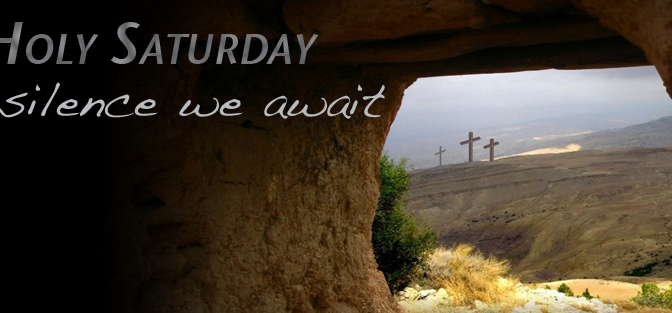






















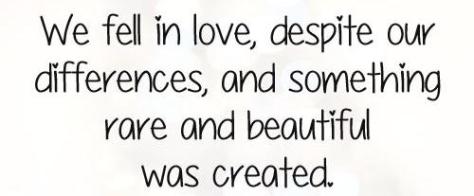

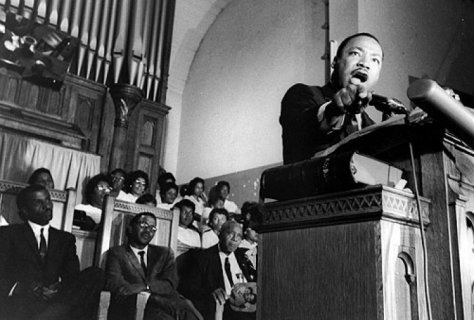


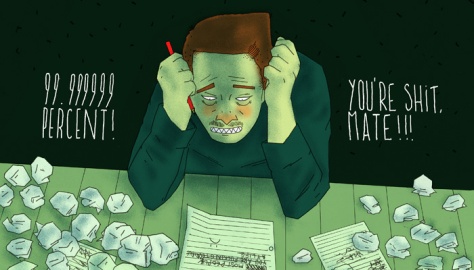




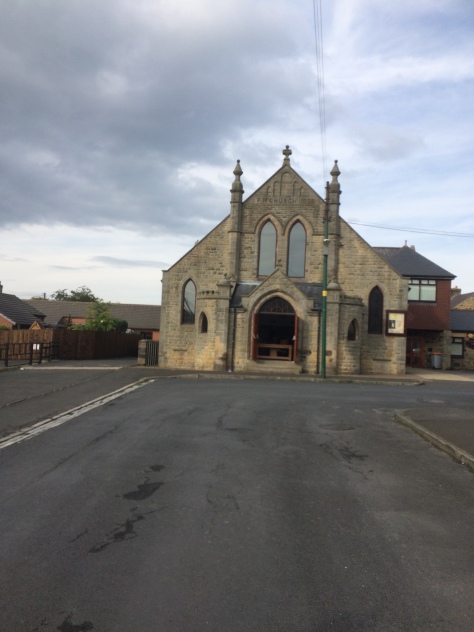




 My experience this year has been that the worship has been powerfully moving. In the evening celebrations in particular, care has been taken to ensure that there is time for prayer ministry after each speaker. This has been hugely beneficial offering not only opportunity for people to respond to what they have heard, it has also provided a space for the Spirit to minister, and sometimes this has been independent of whatever the preacher may have said.
My experience this year has been that the worship has been powerfully moving. In the evening celebrations in particular, care has been taken to ensure that there is time for prayer ministry after each speaker. This has been hugely beneficial offering not only opportunity for people to respond to what they have heard, it has also provided a space for the Spirit to minister, and sometimes this has been independent of whatever the preacher may have said.  ECG2015 is now complete and we’ve booked for 2016. I suggest you do the same!
ECG2015 is now complete and we’ve booked for 2016. I suggest you do the same! Bibles studies this year were led by Tom Greggs in the Grand Hall and by Katherine Stephens & Elaine Lindridge in The Theatre. Katherine and Elaine are Methodist ministers in the Newcastle District and Tom is Professor of Divinity at Aberdeen University. Both studies looked at Ephesisans 1-4 under the overarching theme of Together.
Bibles studies this year were led by Tom Greggs in the Grand Hall and by Katherine Stephens & Elaine Lindridge in The Theatre. Katherine and Elaine are Methodist ministers in the Newcastle District and Tom is Professor of Divinity at Aberdeen University. Both studies looked at Ephesisans 1-4 under the overarching theme of Together. This year I spent most of my time in the bible studies led by Tom Greggs. Tom is a Methodist local preacher and manages to combine great preaching capacity with excellent theological understanding and depth. He is knowledgeable and profound, but perhaps more importantly passionate about the person of Jesus. It was a really fantastic experience to engage with someone who is an internationally respected theologian of the highest order, but who was accessible without dumbing down the theology. This is more difficult than it sounds.
This year I spent most of my time in the bible studies led by Tom Greggs. Tom is a Methodist local preacher and manages to combine great preaching capacity with excellent theological understanding and depth. He is knowledgeable and profound, but perhaps more importantly passionate about the person of Jesus. It was a really fantastic experience to engage with someone who is an internationally respected theologian of the highest order, but who was accessible without dumbing down the theology. This is more difficult than it sounds.  However, whilst the bible studies have been brilliant, I have been most ministered to by the 5 evening celebrations this year. These have been times of fantastic worship and powerful preaching, but even more importantly, there has been opportunity and openness to the moving of the Spirit. On occasion it’s not been the preaching which has struck a chord, but a powerful sense of the ministry of the Spirit.
However, whilst the bible studies have been brilliant, I have been most ministered to by the 5 evening celebrations this year. These have been times of fantastic worship and powerful preaching, but even more importantly, there has been opportunity and openness to the moving of the Spirit. On occasion it’s not been the preaching which has struck a chord, but a powerful sense of the ministry of the Spirit.